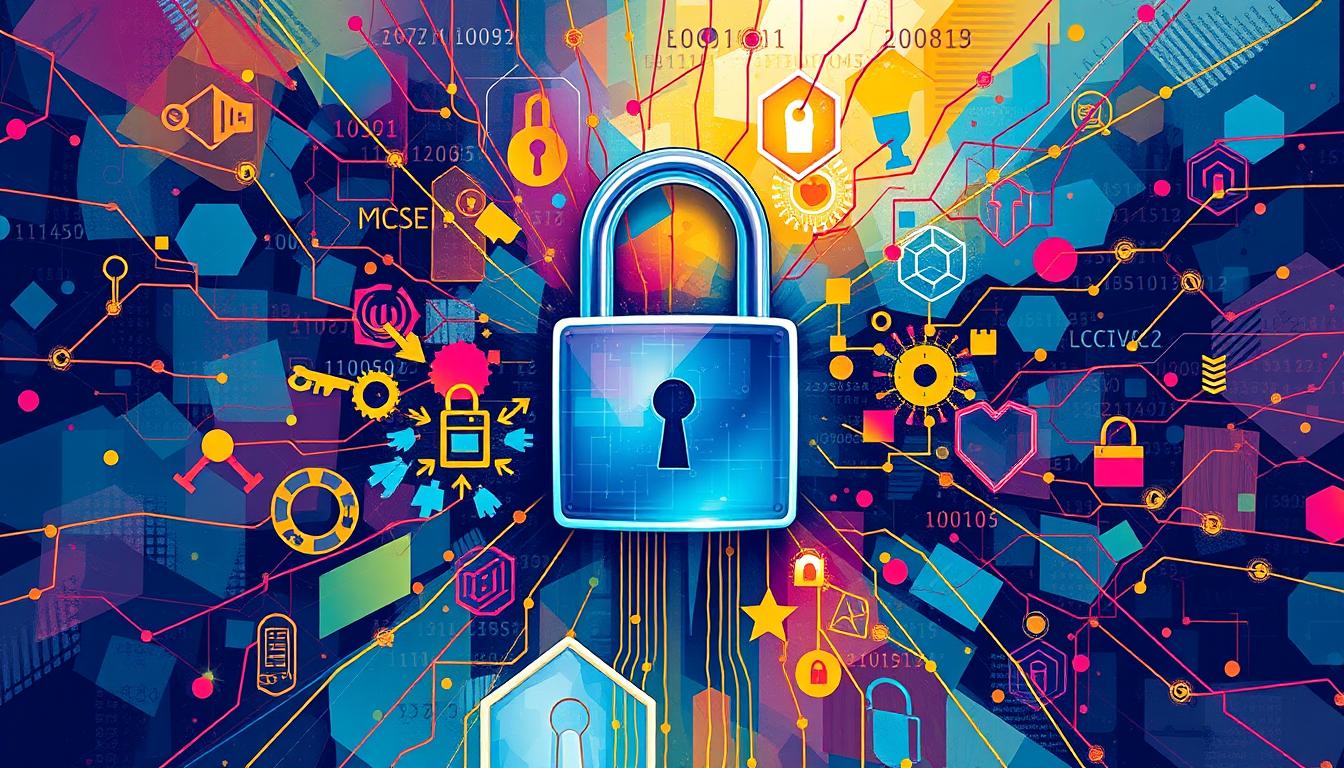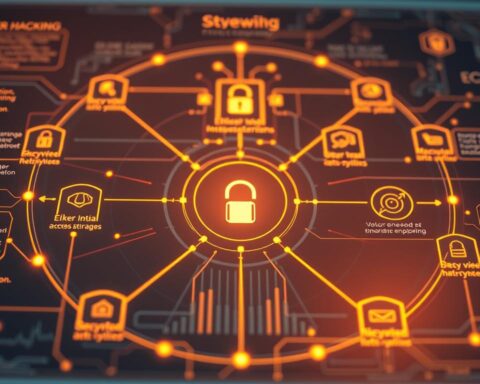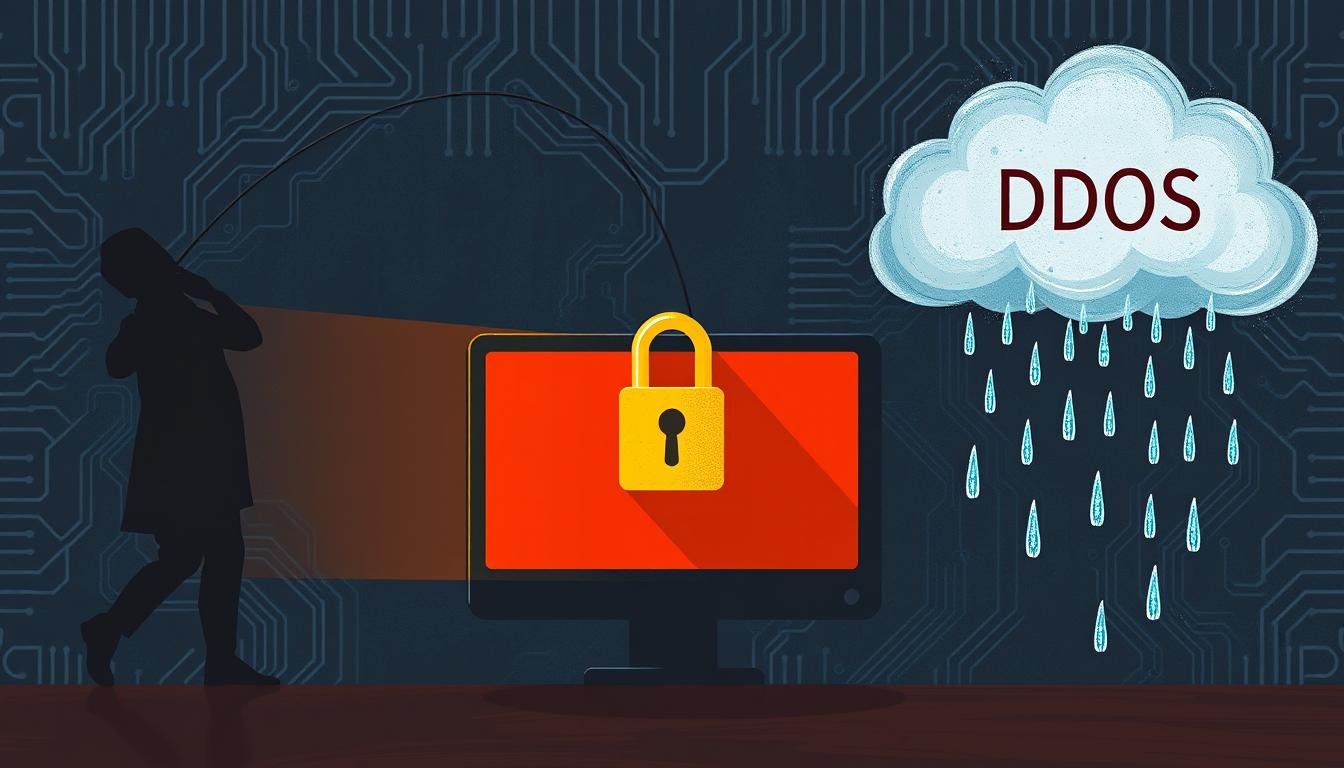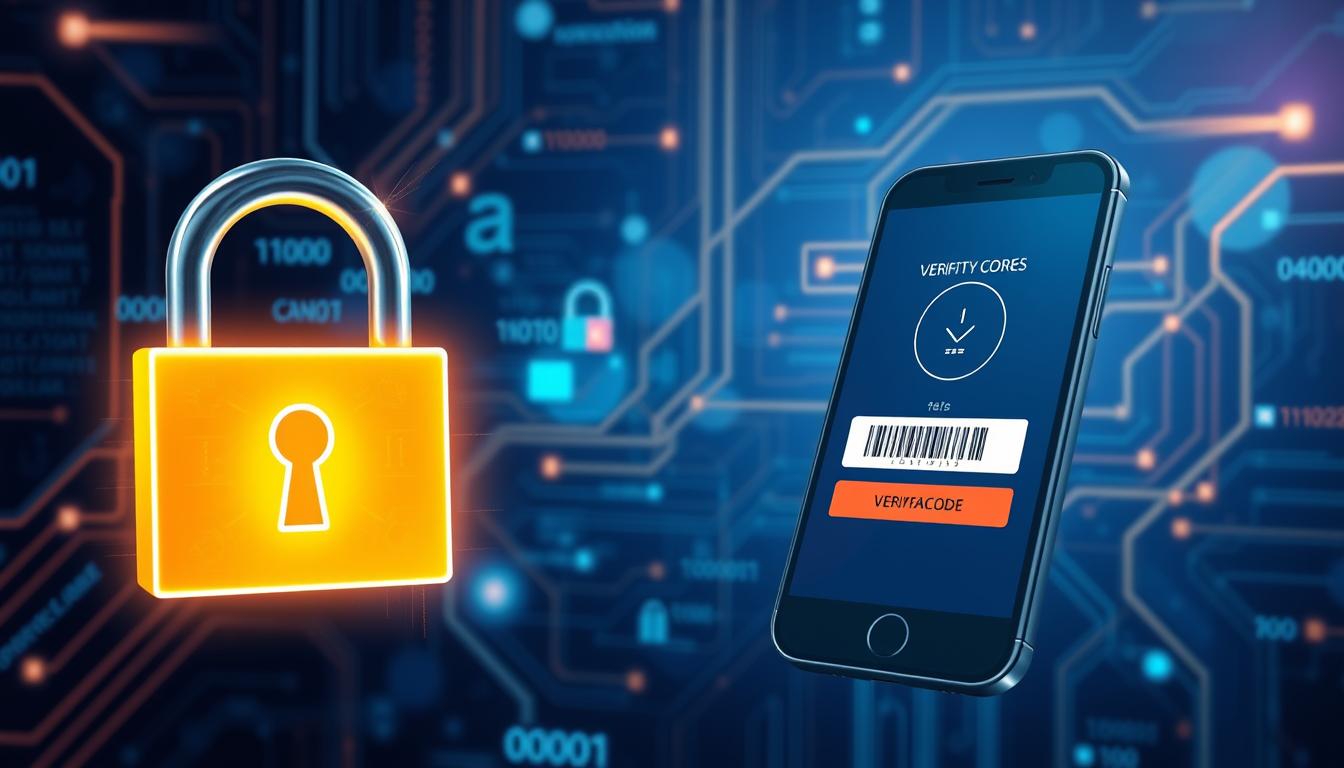Did you know that 62% of data breaches involve stolen user credentials? This shows how vital strong password security is today1. Welcome to Day 4 of our Cybersecurity Training. We’ll explore password basics and how to make strong, secure passphrases.
In today’s world, passwords are our first defense against cyber threats. Yet, many systems and services have been breached because of weak passwords1. This guide will teach you how to strengthen your online security. We’ll start with the basics: your passwords.
As we delve into password security, you’ll see why old methods don’t work anymore. You’ll learn how passphrases can greatly improve your protection against cyber attacks. Get ready to discover how to create strong, secure passphrases that can face today’s digital threats.
Key Takeaways
- Strong passwords are crucial for protecting against data breaches
- Traditional password methods are increasingly vulnerable to attacks
- Passphrases offer enhanced security over simple passwords
- Proper password practices are essential for overall cybersecurity
- This guide will provide actionable strategies for creating secure passwords
- Understanding password basics is key to protecting your digital identity
Understanding the Importance of Password Security
In today’s digital world, passwords are our first defense against hackers. With over 1,100 data breaches in 2023, millions of records were exposed2. This shows how crucial strong passwords and good data protection are.
The Role of Passwords in Digital Security
Passwords protect our digital lives, from emails to bank accounts. The FBI suggests using passphrases instead of simple passwords3. Passphrases, made of 4 to 5 random words, are more secure and easier to remember than short passwords3.
Common Password Vulnerabilities
Many people use easy-to-guess passwords or common phrases. Sadly, 60% of users reuse passwords, making them easy targets for hackers4. Weak passwords like “123456” or “password” also invite attacks3.
Impact of Password Breaches
Password breaches can lead to big problems, like financial loss or identity theft. Weak or stolen passwords cause 81% of data breaches4. To stay safe, experts advise making strong passwords at least 12 characters long2.
Using Two-Factor Authentication (2FA) can cut down unauthorized access by up to 99.9%4. As our digital world gets more complex, keeping our passwords safe is key to protecting our online identities and data.
Password Basics: Creating Strong, Secure Passphrases
In today’s digital world, making strong passphrases is key. It’s more than just letters and numbers. Creating strong passphrases is vital to keep your online data safe5.
Strong passwords stop hackers from getting to your personal info, like money. Weak passwords are easy to guess and can cause big security problems, like data theft5. Sadly, over 80% of data breaches happen because of weak passwords. Also, 63% of people use the same password for many accounts, making them more vulnerable6.
To make a strong passphrase, aim for 12 characters or more. Mix in upper and lower case letters, numbers, and special characters. This makes it hard for hackers to guess5. It’s scary that hackers can guess a weak password in under 30 seconds6.
“Passphrases made of four or more random words can increase password strength significantly, making brute force attacks impractical.” – National Institute of Standards and Technology (NIST)
Think about using a password manager to keep your passphrases safe. People who use password managers have 50% fewer password breaches6. Also, change your passphrases often, especially for important accounts5.
| Password Type | Example | Strength |
|---|---|---|
| Weak | password123 | Very Low |
| Strong | Tr3e!House@Sky99 | High |
| Passphrase | correct horse battery staple | Very High |
Use different passphrases for each account to avoid risks from password reuse. If one passphrase is hacked, your other accounts stay safe5. By following these tips, you’ll greatly improve your online security.
Essential Components of Strong Passwords
Creating strong passwords is key to keeping your data safe. Let’s look at what makes a password secure and hard to guess.
Length Requirements
Password length is very important for security. A good password should be 12-16 characters long to fight off hackers7. Short passwords like “12345” can be broken in seconds by automated tools. This shows why longer, more complex passwords are better8.
Character Diversity
Using a variety of characters makes your password stronger. Mix in uppercase and lowercase letters, numbers, and special symbols like &, !, @, and # in your passwords7. This mix makes it harder for hackers to guess your password and protects against dictionary attacks, which 60% of hackers use7.
Complexity Guidelines
Here are tips for making complex, secure passwords:
- Use at least six words in a passphrase for stronger security9
- Avoid reusing passwords across multiple accounts9
- Employ password managers to generate and store unique passwords9
- Consider using fictional answers for security questions9
NIST Password Standards
The National Institute of Standards and Technology (NIST) suggests using the longest password or passphrase you can. For example, “Pattern2baseball#4mYmiemale!” is a strong password because of its length and mix of characters.
| Password Component | Importance | Best Practice |
|---|---|---|
| Length | Critical | 12-16 characters minimum |
| Character Mix | High | Use uppercase, lowercase, numbers, and symbols |
| Uniqueness | Essential | Create a different password for each account |
| Memorability | Important | Use passphrases or password managers |
By following these tips, you can make your passwords much stronger. Remember, 81% of data breaches are caused by weak or stolen passwords. This shows how important strong passwords are for keeping your digital life safe7.
Common Password Mistakes to Avoid
In the world of cybersecurity, knowing the basics of passwords is key. Yet, many people unknowingly put their digital safety at risk. Let’s look at these mistakes and how to improve our security.

One big mistake is using the same password everywhere. About 65% of people reuse their passwords, making them easy targets for hackers10. If one account gets hacked, all others linked to it could be at risk too.
Using simple passwords is another big error. In 2020, “123456” and “password” were among the top 10 most common passwords, found in 25% of data breaches10. These easy-to-guess passwords can be cracked quickly, putting your data in danger.
Password length is also crucial. Passwords shorter than 8 characters are much easier to crack than longer ones10. In fact, tools can guess passwords of 8 characters or less in under 3 seconds11.
Many people don’t understand the need for complex passwords. Over 50% of users don’t see the importance of password complexity, leading to security issues10. Simple words or phrases can be guessed in about 60 seconds using dictionary attacks10.
Finally, not updating passwords often is a common mistake. Experts say to change passwords every 3 to 6 months to stay safe10. But, more than a third of users only change their passwords once a month, and 15% do it weekly11.
By avoiding these common password mistakes, we can greatly improve our cybersecurity. This helps protect our valuable data from potential threats.
Implementing Multi-Factor Authentication
Multi-factor authentication (MFA) is a key part of keeping your accounts safe. It adds an extra layer of security. This makes it harder for hackers to get into your accounts12.
Types of Authentication Factors
MFA uses three main ways to verify you:
- Knowledge: Something you know (password, PIN)
- Possession: Something you have (security token, smartphone)
- Inherence: Something you are (fingerprint, facial recognition)
While SMS codes are common, they’re not as safe as other options. FIDO authenticators and Web Authentication API are much stronger against phishing12.
Benefits of MFA
MFA has many benefits:
- It makes your accounts more secure, even if someone guesses your password.
- It’s great at stopping phishing attacks12.
- It helps you meet data protection rules.
Implementation Strategies
To set up MFA well:
- First, pick the most important systems. These are the ones with sensitive info like health data or personal info12.
- Then, choose strong methods. Go for phishing-resistant options instead of SMS12.
- Make sure everyone knows why MFA is important for security12.
- Use a password manager. It helps you make and keep strong, unique passwords safely1312.
By following these steps, you can make your cybersecurity much stronger. This helps keep your sensitive data safe from hackers14.
Password Management Best Practices
Keeping your passwords safe is key to protecting your data and staying secure online. With so many accounts to manage, it’s important to use strong passwords everywhere14.
Password Manager Solutions
Password managers help you create and store strong passwords. They make unique, long passwords for each account, making them nearly unbreakable14. Using a password manager can also cut down on password reuse by 30%, boosting your security15.
Secure Storage Methods
Password managers use encrypted vaults that are safer than writing down passwords in a notebook14. If you prefer to manage passwords yourself, use long passphrases of at least 15 characters15. Don’t use common words or personal info in your passwords, as hackers can easily guess them16.
Regular Password Updates
Changing passwords often is not always necessary unless you suspect a breach or get a data breach notice14. Instead, aim for unique, strong passwords for each account. Adding multi-factor authentication (MFA) can let you use slightly shorter passwords, thanks to the extra security1615.
Following these password management tips can greatly enhance your online security. It helps keep your personal info safe from unauthorized access.
Protecting Passwords Across Different Devices
In today’s digital world, keeping passwords safe on various devices is key. We use many platforms to access important info, each with its own security issues.
Strong passwords are vital for keeping devices secure. An 8-character password has over 208 billion possible combinations. But, a 12-character password has an astonishing 95 quadrillion options17. Yet, hackers can guess an 8-character Windows password in just 6 hours18.
To make passwords stronger on all devices:
- Use passphrases of 20 characters or more
- Mix different types of characters
- Don’t save passwords in browsers
- Use biometric authentication when it’s available
- Keep device software and apps up to date
Password managers help manage many secure passwords. They let you create and store complex, unique passwords for each account without having to remember them all18.
Public computers and Wi-Fi networks are risky. Always log out of important accounts on shared devices. Also, avoid using public networks for sensitive activities like banking or email.
| Device Type | Unique Security Measures |
|---|---|
| Computers | Strong login passwords, disk encryption |
| Smartphones | Biometric locks, remote wipe capabilities |
| Tablets | Secure lock screen, app-level passwords |
By following these tips, you can greatly improve your password security. This ensures your data is well-protected in our connected world.
Corporate Password Policies and Compliance
Organizations must focus on strong cybersecurity by setting up good password policies. These policies are key to keeping data safe from hackers.
Policy Development Guidelines
Creating password policies should start with password basics that meet industry standards. Strong passwords should be at least 8 characters long. They should mix uppercase and lowercase letters, numbers, and symbols19.
It’s important to limit password length to 64 characters. Also, allow all ASCII characters, including spaces and emojis19.
Employee Training Requirements
Training employees regularly is key to keeping passwords safe. They should know the dangers of using the same password for work and personal accounts20. Training should cover:
- Creating strong, unique passwords
- Recognizing phishing attempts
- Using password managers
- Enabling multi-factor authentication
Compliance Monitoring
To make sure policies are followed, organizations need monitoring systems. These systems track password changes and detect weak passwords. They also flag suspicious login attempts. Companies should lock accounts after 10 failed login attempts to stop brute-force attacks19.
By following these steps, businesses can greatly improve their cybersecurity. This helps protect sensitive data from hackers.
Conclusion
Learning about password basics and making strong passphrases is key to keeping your online world safe. Weak or stolen passwords cause 81% of data breaches, showing how important it is to use strong passwords21. Experts say to make passwords at least 12 characters long to make them harder to guess2122.
But, 59% of people use the same password for many accounts, which makes it easier for hackers to get into all of them21. To avoid this, it’s best to use a different password for each account. This way, if one account gets hacked, the others are safer22. Using passphrases, which are sequences of words or sentences, is also a good idea22.
Using multi-factor authentication (MFA) adds an extra layer of security, but 73% of people don’t use it21. MFA combines a password with a code sent to your phone, making your account much safer22. Password managers can also help by keeping your passwords safe and unique for all your accounts21.
As cybersecurity keeps changing, it’s important to stay up to date and be proactive. By following these tips and keeping your passwords and security up to date, you can protect your digital world from hackers.
FAQ
What makes a passphrase stronger than a traditional password?
Passphrases are longer and more complex than passwords. They’re easier to remember because they use unrelated words. For example, “correct horse battery staple” is hard to guess but easy to remember.
How long should my password or passphrase be?
NIST says passwords should be at least 8 characters. Passphrases should be 20 characters or more. The longer it is, the more secure it becomes.
Is it necessary to include special characters in my passphrase?
Special characters can add complexity. But, length is more important. If you use special characters, make sure they’re not hard to remember or type.
How often should I change my passwords?
Change passwords only when they’re compromised. Frequent changes can lead to weaker passwords. Create strong, unique passwords for each account and use multi-factor authentication.
What is multi-factor authentication (MFA) and why is it important?
MFA requires two or more forms of identification. It adds a layer of security beyond passwords. Even if an attacker gets your password, they need the second factor to access.
Are password managers safe to use?
Reputable password managers are safe. They use strong encryption and can generate complex passwords. But, choose a well-established manager and protect your master password well.
What should I do if I suspect my password has been compromised?
If you suspect a password breach, act fast. Change the password for the affected account and similar ones. Enable MFA and watch for suspicious activity. Consider a password manager for unique passwords.
How can I create a memorable yet secure passphrase?
Use unrelated words that create a vivid image. For example, “dancing elephant eats purple spaghetti” is memorable and secure. Avoid common phrases and personal info.
What are some common password mistakes to avoid?
Avoid using personal info, reusing passwords, and simple words. Don’t store passwords insecurely. Never share your passwords and avoid predictable patterns.
How can organizations enforce strong password policies?
Use technical controls for password length and complexity. Prohibit password reuse and require MFA. Train employees, conduct audits, and use password management tools to enhance security.
Source Links
- Choosing and Protecting Passwords | CISA – https://www.cisa.gov/news-events/news/choosing-and-protecting-passwords
- The Ultimate Guide to Password Management – https://www.msecure.com/blog/securing-your-digital-life-the-ultimate-guide-to-password-management/
- Passphrase vs Password: Choosing the Right Key to Your Digital Security – https://www.linkedin.com/pulse/passphrase-vs-password-choosing-right-key-your-digital-david-kidd-fmnle
- Why Is Password Protection Important? A Comprehensive Guide – Newsoftwares.net Blog – https://www.newsoftwares.net/blog/why-is-password-protection-important-a-comprehensive-guide/
- How to Create a Strong Password in 6 Steps? Importance & Practices – https://www.eccu.edu/blog/technology/the-importance-of-strong-secure-passwords/
- Create good passwords | Own Your Online – https://www.ownyouronline.govt.nz/personal/get-protected/guides/how-to-create-good-passwords/
- Six Tips for Creating a Strong Password for Better Online Security – https://www.defastlink.net/six-tips-for-creating-a-strong-password-for-better-online-security/
- Creating a Strong Password | Ascendant – https://ascendantusa.com/2024/01/03/strong-password/
- Creating Strong Passwords – https://ssd.eff.org/module/creating-strong-passwords
- Six Tips for Creating a Strong Password for Better Online Security – https://www.thinkbignets.com/six-tips-for-creating-a-strong-password-for-better-online-security/
- 10 Bad Password Examples: Avoid These Common Mistakes – https://www.dashlane.com/blog/bad-password-examples-mistakes-to-avoid
- Multi-Factor Authentication – https://www.nist.gov/itl/smallbusinesscyber/guidance-topic/multi-factor-authentication
- Week 1 – Pump Up Your Password – https://security.sdsu.edu/be-cyber-smart/awareness/2023/week-1
- Create and Use Strong Passwords – National Cybersecurity Alliance – https://www.staysafeonline.org/articles/passwords
- Best practices for passphrases and passwords (ITSAP.30.032) – Canadian Centre for Cyber Security – https://www.cyber.gc.ca/en/guidance/best-practices-passphrases-and-passwords-itsap30032
- Password Best Practices | UC Santa Barbara Information Technology – https://www.it.ucsb.edu/general-security-resources/password-best-practices
- Passphrase vs. Password: Which Secures Better? – Blue Goat Cyber – https://bluegoatcyber.com/blog/passphrase-vs-password-which-secures-better/
- How to Create Strong Passwords and Stay Secure Online – https://cyberinsider.com/strong-password/
- NIST Password Guidelines – https://blog.netwrix.com/nist-password-guidelines
- The Importance of a Strong and Secure Password – https://gracehill.com/blog/the-importance-of-a-strong-and-secure-password/
- Don’t Be a Victim: The Importance of Secure Passwords – Institute of Technology – https://technology.nirmauni.ac.in/dont-be-a-victim-the-importance-of-secure-passwords/
- Password Hygiene: Creating Strong and Memorable Passwords – https://medium.com/@spress0609/password-hygiene-creating-strong-and-memorable-passwords-6630e99703a5










